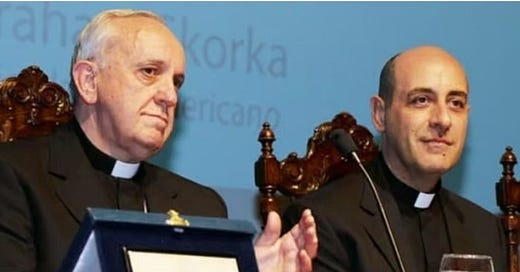Interlude: The Church speaks
Yesterday's document: New norms for discerning alleged supernatural events
As most of you have probably noted, our current series of posts has addressed the phenomenon of false mysticism. I was thus understandably astonished (and relieved) to see these new norms, issued yesterday by the Dicastery for the Doctrine of the Faith, under the signature of the Prefect, Víctor Manuel Cardinal Fernández.
In his presentation of the norms, Cardinal Fernández writes that “in some events of alleged supernatural origin, there are serious critical issues that are detrimental to the faithful.” He notes with concern that “some Bishops… make statements such as, ‘I confirm the absolute truth of the facts’ and ‘the faithful must undoubtedly consider as true…’,” adding that “[t]hese expressions effectively oriented the faithful to think they had to believe in these phenomena, which sometimes were valued more than the Gospel itself.” He goes on to state that:
When considering such events, one should not overlook, for example, the possibility of doctrinal errors, an oversimplification of the Gospel message, or the spread of a sectarian mentality. Finally, there is the possibility of believers being misled by an event that is attributed to a divine initiative but is merely the product of someone’s imagination, desire for novelty, tendency to fabricate falsehoods (mythomania), or inclination toward lying.
As for the norms themselves, they clearly acknowledge the challenges presented by contemporary media:
With the advent of modern means of communication, these phenomena [“alleged apparitions, visions, interior or exterior locutions, writings or messages, phenomena related to religious images, and psychophysical phenomena”] can attract the attention of many believers or cause confusion among them. Since news of these events can spread very quickly, the pastors of the Church are responsible for handling these phenomena with care by recognizing their fruits, purifying them of negative elements, or warning the faithful about potential dangers arising from them.
and have no naiveté regarding what the dangers cited might be:
The Diocesan Bishop should exercise particular care, even using the means at his own disposal, to prevent the spread of confused religious manifestations or the dissemination of any materials pertaining to the alleged supernatural phenomenon (such as the weeping of sacred images; the sweating, bleeding, or mutation of consecrated hosts, etc.) to avoid fueling a sensationalistic climate.
Bishops are enjoined to exercise appropriate discipline:
If the alleged supernatural events continue during the investigation and the situation suggests prudential measures, the Diocesan Bishop shall not hesitate to enforce those acts of good governance to avoid uncontrolled or dubious displays of devotion, or the beginning of a veneration based on elements that are as of yet undefined.
Under these new norms, the Church will go no further than nihil obstat (nothing contrary to faith and morals) in judging events of “alleged supernatural origin.” The remaining categories are prae oculis habeatur (to be kept under consideration), a probational and precautionary discernment where grace seems operative but some reservations remain; curatur (under observation), a more precautionary status applied where there are serious grounds for caution and the momentum of the faithful must be guided and led in the most wholesome direction possible; sub mandato (under command), by which the Church takes charge of a situation where an individual or individuals appear to be taking advantage of sincere believers; prohibetur et obstruatur (prohibited and obstructed), for cases damaging in their origin, their content, and/or their fruits; and a declaration of non supernaturalitate, reserved for cases of confessed or empirically demonstrated fraud.
Particularly telling is the suspension of de supernaturalitate (of supernatural origin) declarations on the part of the Church. To my knowledge, the Church’s main formal discernment of contemporary supernatural events relates to canonization processes. A de supernaturalitate declaration would seem in effect to canonize, analogously speaking, an ongoing (actually or putatively) spiritual event. Worse still, by a false but all too likely extrapolation, enthusiasts among the devout would extend this canonization to the living “visionaries” or “mystics” themselves.
Worst of all, such enthusiasms, by their immediacy and their play on the emotions, can easily come to supplant the Church and the true Christ found in the Gospels and the Eucharist. This shows the urgency of the distinction between the miraculous quoad modum and quoad substantiam which Val made in passing in the first installment of the current series – any range of signs and wonders, all the dancing lights and celestial music in the world, up to and including non-glorious resuscitation of the dead, bear far more resemblance to everyday natural-order events like reading this post than they do to substantially miraculous events like the glorious Resurrection of Christ on the third day, or the Redemption he won for us. (Val is intending to write more on this subject, which will make this last statement clearer.)
On a personal note, I grew up with an image of the Fatima apparitions on my bedroom wall, and was brought to Lourdes on pilgrimage by my parents at the age of seven. However, for whatever reason, I never took private revelations particularly seriously, either way – which extended to a fairly indulgent attitude about dubious- or absurd-seeming ones. True, the ultimate criteria are Scripture and tradition; true, also, that public revelation ended with the death of the last apostle, John the Beloved; true, finally, that there is no obligation to believe in anything said to be supernaturally revealed at any point thereafter, however pious the visionary or commended by the Church the event might be. Yet I entered adulthood with no more than the odd surmise that perhaps the real purpose of such signs and wonders was to draw skeptics and unbelievers into the Church by the evidence of their own senses – a proposition as dangerous as it is unlikely.
I somehow failed to realize at the time the moral enormity involved when people claim to be speaking in the name of God – and the damage that they do when in such claims, as I recently wrote to a professor of mine from years past, “virtually every sentence contradicts some combination of Scripture, tradition, history, human dignity, and common sense.” Yet the final insult, and the worst damage, is when they so offend against faith and reason alike and are yet tolerated – even encouraged – within the Church.
Val deserves tremendous credit here. The phenomenon of false mysticism has been a lifelong issue for her; since happening on the USCCB commendations of Cora Evans a year ago, she has been acutely troubled. Her investment in work and suffering and the blows to her faith have been prodigious. But she persisted – and this is not the first time the Church has spoken in medias res to an issue on which she was working.
It is not enough to dismiss claimed private revelation as the realm of pious if slightly hysterical women – besides being sexist and clericalist, it is a profound scandal to those of us clinging to the Barque of Peter by the threads of religio vera – not as meaning the religion that is the truth, or even as meaning the religion that is true (claims which ring with just authority in our ears but sour into triumphalism in our mouths). No, our faith is religio vera as the “religion of the Logos,” as Ratzinger puts it, the religion which is solicitous of the truth, reverent with the truth, careful in everything to honor the truth, for we worship the Truth who is also the Way and the Life. And that – and here, again, full credit to Val who identified this – is the ultimate objection to fanciful myth-making about the Blessed One: it’s blasphemy. And sacrilege. Intended so or not, that is what it is.
Humans crave communal support, crave novelty and diversion and entertainment. We are born needing food and shelter and care; we are hard-wired for survival and reproduction. Truth is an acquired taste – but it is truth, and the love which truth makes possible (for you cannot love what you do not know), by which we are human, and it is Christ the Truth who leads us on the path to divinization. Perhaps only from eternity will we see the full measure of what Cardinal Fernández – and his sponsor and mentor, the Holy Father – have done for the Church and for souls by this work.





